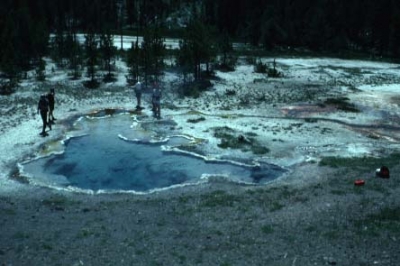
The scientific community was understandably shocked in the late 1970s by the discovery of an entirely new group of organisms — the Archaea. Dr. Carl Woese and his colleagues at the University of Illinois were studying relationships among the prokaryotes using DNA sequences, and found that there were two distinctly different groups. Those “bacteria” that lived at high temperatures or produced methane clustered together as a group well away from the usual bacteria and the eukaryotes. Because of this vast difference in genetic makeup, Woese proposed that life be divided into three domains: Eukaryota, Eubacteria, and Archaebacteria. He later decided that the term Archaebacteria was a misnomer, and shortened it to Archaea. The three domains are shown in the illustration above at right, which illustrates also that each group is very different from the others.
Archaeans include inhabitants of some of the most extreme environments on the planet. Some live near rift vents in the deep sea at temperatures well over 100 degrees Centigrade. Others live in hot springs (such as the ones pictured above), or in extremely alkaline or acid waters. They have been found thriving inside the digestive tracts of cows, termites, and marine life where they produce methane. They live in the anoxic muds of marshes and at the bottom of the ocean, and even thrive in petroleum deposits deep underground.
Archaeans may be the only organisms that can live in extreme habitats such as thermal vents or hypersaline water. They may be extremely abundant in environments that are hostile to all other life forms. However, archaeans are not restricted to extreme environments; new research is showing that archaeans are also quite abundant in the plankton of the open sea. Much is still to be learned about these microbes, but it is clear that the Archaea is a remarkably diverse and successful clade of organisms.
Picture Credit : Google




